|
|
6th South African Armoured Division (Part 3)
|
Gothic Line Battles
The South African advance re-commenced with the 6th South African Armoured Division heading north on Route 64 with the US II Corps to their right and 34th US Infantry Division on the left. Reports had been received that the 16. SS-Panzergrenadierdivision had taken over from the German 362. Infanteriedivision and that they were now defending the front ahead of the 6th South African Armoured Division. The division advanced along the axis running between Prato and Castiglione dei Pepoli. The 11th South African Armoured Brigade was ordered to advance up Highway 6620 (the Prato-Bologna road) while the 12th South African Motorised Brigade moved up Highway 64. By 27 September 1944, the FC/CTH had crossed the main Appenine watershed at Collin, and the ILH/KimR had reached the southern outskirts of Castiglione Del Pepoli. By 28 September 1944, the 6th South African Armoured Division was advancing on three widely separated axes, retreating German forces were demolishing bridges, culverts and roads and this, with traffic congestion on limited roads, made passage extremely slow. It was then decided to hand over Route 66 to Task Force 92, as the South African engineers were not able to maintain the three parallel routes simultaneously. This permitted the 24th Guards Brigade to re-unite with the 11th South African Armoured Brigade in protecting the US II Corps’ western flank.
|
The 24th Guards Brigade was ordered to capture the Catarelto Ridge and exploit 6000 yards beyond. The 11th South African Armoured Brigade was to protect their left flank by capturing Mt. Vigese. The 12th South African Motorised Brigade was to be held in divisional reserve in the Montale area. The artillery was considerably strengthened when the 178th (Lowland) Medium Regiment, Royal Artillery came under the 6th South African Armoured Division command, and two American 240mm howitzers from the 697th US Field Artillery Battalion and one 8” Gun M1 from the 575th US Field Artillery Battalion moved into the divisional area. In addition, the 6th South African Armoured Division was heavily reinforced with Combat Command “B”, an Armoured Brigade from the 1st US Armored Division.
|
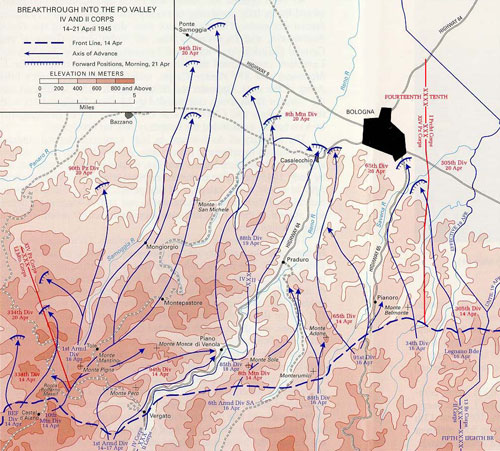 |
Traffic movement on 28 September 1944, was extremely difficult owing to rain and mud, and only two Companies of 1st Battalion, Scots Guards and a Troop of “A” Squadron, PR reached Castiglione during the day. The 11th South African Armoured Brigade were unable to give any information about the enemy, but that afternoon the 1st Battalion, Scots Guards advancing along the Catarelto Ridge made contact with the enemy in a thick mist. At dawn on 29 September 1944, the 1st Battalion, Scots Guards resumed their advance, and in spite of a certain amount of machine-gun and mortar fire cleared the greater part of the ridge. It was found that the Germans were holding Mt. Catarelto in strength.
|
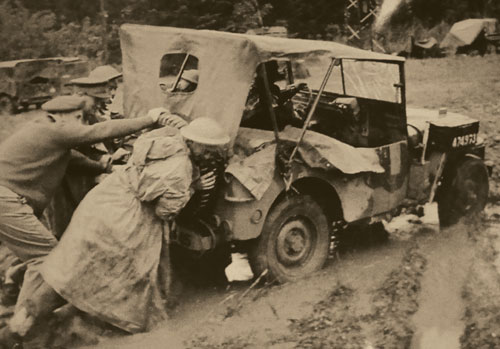 |
The attack developed on 30 September 1944, and met with fierce opposition. The PR managed to get two Stuart tanks on to the ridge and they were able to give some machine-gun support. The 1st Battalion, Scots Guards got within 200 yards of the crest of Catarelto, but the enemy’s resistance was fanatical. It was impossible to advance further, and during the night and at dawn, the Germans sent in two strong counterattacks. Very hard fighting followed, and the Guards were assisted by the mortars and machine guns of “B” Group.
|
|
The 166th NFLD (Newfoundland) Field Regiment, Royal Canadian Artillery
was in close support and the 7/23 Medium Regiment, SAHA brought down
fire at their request. Although the 1st Battalion, Scots Guards were
forced to draw back their left flanking Company, the enemy did not press
his advantage in the face of very heavy artillery and machine-gun fire.
Attempts were made to bring up the PR tanks to assist the Guards, but
the rain-soaked road began to collapse under their weight.
While this furious struggle was raging on the Catarelto Ridge, “C” Squadron, PR led the advance of 3rd Battalion, Coldstream Guards up the western banks of the Brasimone, and reached the area of Bucciagno directly opposite to Mt. Catarelto. Enemy machine-gun fire was heavy, but attempts by the SS troops to infiltrate during the night of 1/2 October 1944 were beaten off. With the 1st Battalion, Scots Guards having been badly knocked about, 5th Battalion, Grenadier Guards were ordered to storm Mt. Catarelto on 2 October 1944. The attack was delivered in thick mist and blinding rain, and although the attacking troops got within 50 yards of the crest, the Germans refused to be dislodged. Twice the leading Company attempted to storm the crest, and twice they were beaten off. The thick mist greatly restricted supporting fire, and it was decided to call off the attack pending an improvement in the weather.
|
|
Plans were made to resume the assault on 3 October 1944, but during the night of 2/3 October 1944 a Grenadier Guards patrol reached the crest of Catarelto and found that the Germans had withdrawn. The Germans had fallen back along the whole brigade front and 3rd Battalion, Coldstream Guards completed the occupation of the Bucciagno Ridge. The German retreat had probably been hastened by the American occupation of Mt. Del Galletto four miles north-east of Catarelto. Meanwhile, the 11th South African Armoured Brigade was advancing against Mt. Vigese, a dominating feature that towered up on the left flank. On 30 September 1944, the ILH/KimR occupied the village of Camugnano while the 4/13th Frontier Force Rifles on their right flank secured Mt. Fontanavidola.
|
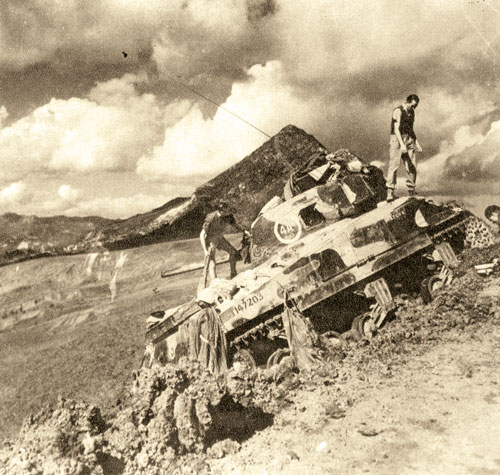 |
|
The advance continued on 1 October 1944, and it was confirmed that the
enemy was holding Mt. Vigese. The RNC was put under 11th South African
Armoured Brigade command.
On 3 October 1944, “C” and “D”, ILH/KimR passed through the RNC and
advanced against the southern spurs of Mt. Vigese. “D” Company, ILH/KimR
took Cardeda after a brisk engagement and then occupied Torlai. The
night was wet and dark, and at 23:30 the platoon in Torlai was heavily
attacked. The infantrymen fought until their ammunition ran out and then
executed an extremely skilful and orderly withdrawal.
Further enemy attacks were broken up by artillery fire. Attempts by “D”
Company, ILH/KimR to retake Torlai on 4 October 1944, were unsuccessful
and the enemy’s mortar and rocket fire inflicted many casualties. The
blast effect of the rocket projectiles was devastating. SSB tanks,
trying to assist “D” Company, ILH/KimR lost tracks or bellied in mud. On
the night of 4 October 1944, No. 1 Platoon of “D” Company, ILH/KimR
again attacked Torlai and after fierce house-to-house fighting cleared
the village.
At 02:00 the Germans launched a counterattack in force and desperate fighting followed. The enemy approached Cardeda but our fire was so heavy that he did not press the attack. The 4/22 Field Regiment, SAA bombarded Torlai with good effect and the battle died down at 05:00. A patrol sent out that morning established that the enemy was still holding Torlai. The events of the previous two days had shown the futility of attempting to hold Torlai with small pockets. At last light on 5 October 1944, “A” and “B” Companies, ILH/KimR concentrated at Greglio with “C” Company, ILH/KimR some 1200 yards in rear. “A” Company, ILH/KimR was ordered to take the summit of Mt. Vigese and establish a platoon on a position overlooking the neck. “B” Company, ILH/KimR was to take Vigo and “C” Company, ILH/KimR to exploit. “A” Company, ILH/KimR moved off at dawn on 6 October 1944, and a platoon made straight for the summit of Mt. Vigese. It was a silent attack without artillery preparation. Advancing up the steep slopes in thick mist the platoon fell upon a German position near the summit and took it completely by surprise. Nine prisoners were taken, including the captain responsible for the Vigese-Vigo area.
|
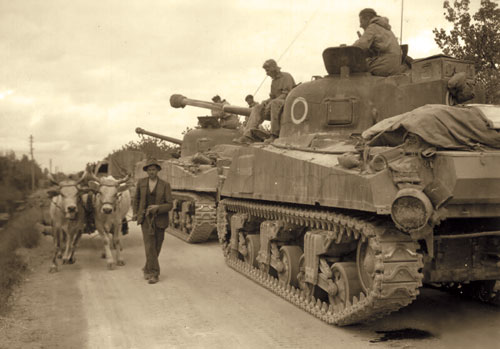 |
A second “A” Company platoon after a sharp fight, captured a machine-gun post halfway down the slope and the Company took up positions overlooking the neck Montevolo and Vigese. Meanwhile, “B” Company, ILH/KimR captured Vigo after calling for artillery support. The Germans in Torlai, finding their retreat threatened, evacuated the village under cover of heavy rain and mist. Patrols on 7 October 1944, found evidence of a considerable withdrawal. The Montevolo massif was clear and Collin and Camplo had been abandoned.
|
|
The successful RNC attack no doubt influenced
this withdrawal, but the enemy probably wished to shorten his front in
view of the heavy American pressure up Highway 65.
The 6th South African Armoured Division intentions for 7 October 1944, stated that the 11th South African Armoured Brigade would advance along the high ground through Prada to Mt Stanco. East of the River Setta the US II Corps had secured an outstanding success by the capture of Monzuno on 5 October 1944. It was intended to pass the 24th Guards Brigade through the Monzuno area to launch an assault on Mt. Sole. Such an attack, if successfull might have compelled the Germans to abandon the whole Stanco-Salvaro feature would have contributed to a decisive break-through to Bologna. Unhappily this movement of the 24th Guards Brigade was cancelled, because of the setback to the 11th South African Armoured Brigade at Mt. Stanco.
|
Brig. J.P.A. Furstenberg decided that the 4/13th Frontier Force Rifles should concentrate at first light on 7 October 1944, in the Camugnano area. The battalion was then to pass through the ILH/KimR, occupy Prada, and capture Mt. Stanco. Thereafter it was to exploit to Mt. Salvaro. The 4/13th Frontier Force Rifles were faced with a difficult task, which involved concentrating in the dark and marching along unscouted tracks and through thick mud for 6000 yards to the ILH/KimR positions. Nevertheless the 4/13th Frontier Force Rifles, after an arduous march and some sharp skirmishes, occupied Mt. Stanco by dusk on 7 October 1944.
|
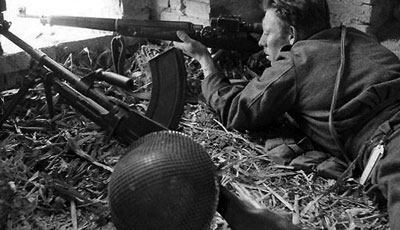 |
| The weather deteriorated during the day and no
jeeps were able to get as far as Mt. Stanco. “A” Company did not come up
until 20:00, after marching continuously for 14 hours. At dawn on 8
October 1944, heavy firing broke out around the mountain, and intense
mortar fire out off the forward Companies from reinforcements in Prada.
The forward observation officer’s jeep and wireless set had been bogged
down en route to the mountain, and it was deemed imprudent to give the
4/13th Frontier Force Rifles artillery support by blind firing. After
two hours fierce fighting the Indians’ ammunition ran out. Mules
bringing up more ammunition were dispersed by shellfire and the mountain
was abandoned. |
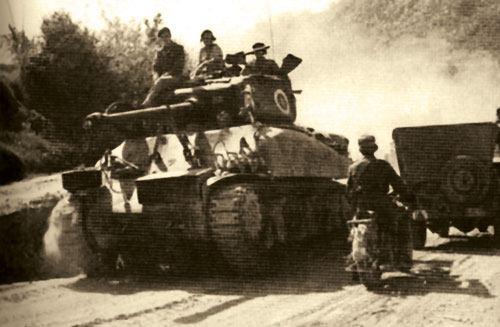 |
On 8 October, divisional orders announced that the line would be held on a four-Brigade front, and for this purpose the 12th South African Motorized Infantry Brigade was moved up to hold the Mt. Vigese-Montevolo area. The 11th South African Armoured Brigade was told to take Mt. Stanco and exploit to Mt. Salvaro. Brig. J.P.A. Furstenberg, now ordered the RNC to secure Mt. Stanco and it was decided to attack on a two-company front – “D” on the right and “B” on the left.
|
|
Advancing at dawn on 10 October 1944, “B” and “D” Companies, RNC made rapid progress, and captured their objectives by 06:40. At 08:40 the enemy was reported to be forming up for a counterattack,
and the whole of the divisional artillery, augmented by the 4.2” mortars
of the RDLI (Royal Durban Light Infantry), brought down their curtain
of fire.
Communications with the guns were not good, and the enemy succeeded in crossing open ground and reaching the bushes on the northern slopes of Mt. Stanco. At 10:05 the SS troops put in a sharp attack and after overrunning the right-hand platoon of “D” Company, RNC captured Forlino. “C” Company, RNC was sent up to recover Forlino, and came under very heavy fire in doing so. After mid-day the enemy’s main attack, estimated at two companies strong, came in from the south-west, taking advantage of a gully. Confused fighting developed and Forward Observation Officers declared that they could not engage without endangering their own troops. “B” Companys left flank was threatened and the “A” Company Commander ordered both “B” and “D” Companies to withdraw. They did so in good order covered by “C” Company.
|
|
Maj. Gen W.H.E. Poole then decided to pause and prepare a divisional attack for the third battle of Stanco, to be led by the 12th South African Motorised Brigade with 11th South African Armoured Brigade and 24th Guards Brigade in support.
“B” and “D” Companies, RDLI and a platoon of “C” Company, RDLI were put under 12th South African Motorised Brigade Command. On 9 October 1944, the 5th Battalion, Grenadier Guards took over the Montorio Ridge from the Americans and on 10 October the 3rd Battalion, Coldstream Guards advanced their line forward of Cisalpina to protect the right flank of the RNC.
|
|
South African Units
RDLI - Royal Durban Light Infantry
NMR - Natal Mounted Rifles
DROR - Duke of Edinburgh’s Own Rifles
RLI - Rand Light Infantry
RB/RPS - Regiment Botha/Regiment President Steyn
PR - Pretoria Regiment
PAG - Prince Alfred’s Guard
SSB - Special Service Battalion
ILH/KimR - Imperial Light Horse/Kimberley Regiment
RNC - Royal Natal Carbineers
FC/CTH - First City/Cape Town Highlanders Regiment
WR/DLR - Witwatersrand/De La Rey Regiment
|
|
| The task of the 12th South African Motorised
Brigade was to take Mt. Stanco and then exploit north-east along the
ridge towards Mt. Salvaro. 11th South African Armoured Brigade was to
protect the left flank, while 24th Guards Brigade was to stage a
demonstration. The attack was to be supported by all available
artillery. Brig. R.J. Palmer decided to assault Stanco on a
two-battalion front, with WR/DLR on the left, and FC/CTH on the right.
The WR/DLR was to capture the summit of the mountain, while the
objective of the FC/CTH was Point 650 on the eastern spur of Mt. Stanco. |
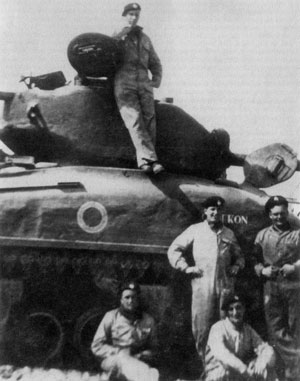 |
At 04:30 on 13 October 1944, the 24th Guards Brigade staged a diversion by attacking Grizzana station. They were supported by a dummy barrage. At 05:00 a terrific artillery bombardment came down on Stanco, thus heralding the largest set-piece attack in which South African troops had taken part in Italy. The 4.2” mortars and medium machine-guns of the RDLI added their weight to the divisional artillery, which fired over 10000 shells at the Germans. Two American Medium Regiments and three American Heavy Guns took part in the bombardment. The attack was supported by 139 guns and the German artillery didn’t remain silent as “A” Company, WR/DLR were heavily shelled on their starting line. Nevertheless the WR/DLR pushed forward with determination. At 05:59 a platoon of “A” Company, WR/DLR reported they had reached the summit of the mountain. The enemy’s machine-gun and mortar fire was very severe, and the Germans clung stubbornly to positions near Stanco village, and in Casa Forlino. The artillery and 4.2” mortars continued to assist the infantry by firing concentrations as called for by the assaulting troops, and “A” and “C” Companies, WR/DLR captured their objectives by 10:20.
|
|
FC/CTH found the opposition more stubborn, and the battalion suffered heavily from very accurate machine-gun fire. Three successive attacks on Point 650 were repulsed. At 11:45 “D” Company, FC/CTH was instructed to take Point 650 “At All Costs”. Twice the enemy attempted to form up for counterattacks, but these efforts were crushed by artillery and mortar fire. By mid-afternoon the mortaring and shelling died down, and the 12th South African Motorised Brigade was secure on Mt. Stanco.
On 15 October 1944, “C” Company, RNC reached the crest of Point 689 without opposition, apart from mortar and artillery fire. Patrols were sent out, and it soon became clear that a serious action would be required to clear the enemy from Mt. Pezza and the massive spur jutting out on the west of the mountain. The 24th Guards Brigade moved forward to conform with Brig. R.J. Palmer’s advance, and the 1st Battalion, Scots Guards occupied Veggio on 15 October 1944. This advance was of the first importance as it opened the road from Castiglione to Grizzana and so did much to ease 12th South African Motorised Infantry Brigades communications. Engineers of 12th Field Squadron, SAEC and 42nd Field Company, RE laboured on the road and by the afternoon opened it for the jeeps. The supply line, however, was completely overlooked from the German positions on Salvaro.
|
Brig. R.J. Palmer decided to attack Mt. Pezza with two battalions supported by troops of “B” Squadron, PAG, who had been able to get their tanks up to the Grizzana area. On the afternoon of 17 October 1944, the RNC attacked Mt. Pezza and the FC/CTH assaulted the western spur. The attack was supported by the 7/23 Medium Regiment, SAHA, 1/6 Field Regiment, SAA and and RDLI. PAG Tanks made a feint down the Carviano road, and drew off much of the enemy’s fire. Nevertheless, the German mortaring and shelling were very heavy, but both battalions took their objectives. During the night of 17/18 October 1944 divisional artillery and mortars brought down defensive fire and frustrated German counterattack plans.
|
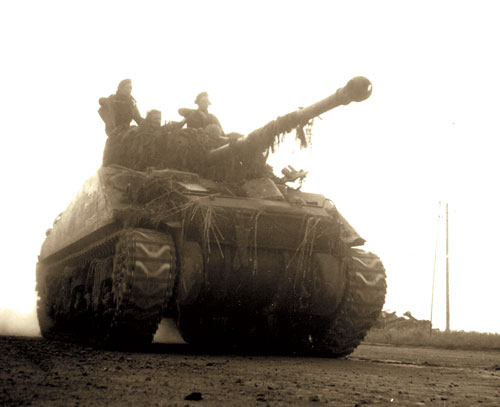 |
On the map Mt. Salvaro looked much like a figure 8, with broad northern and southern sections and a narrow waist. Point 806 is the southern section, and Point 826 in the northern section. The WR/DLR were ordered to capture Point 806 and then exploit to Point 826. The battalion concentrated on Mt. Pezza in thick mist on 18 October 1944. It was arranged for the 24th Guards Brigade to attack Mt. Alcino on 19 October 1944 in conjunction with the WR/DLR attack. “B” and “D” Companies, WR/DLR crossed their Start Line at 05:45 on 19 October 1944, and found the going steep and difficult. For 15 minutes the advance was made in silence, and accordance with the plan the artillery and mortars did not open fire until 06:00. “D” Company, WR/DLR reached Point 806 by 07:40, opposition being slight. Considerable fighting developed on the western side of Salvaro, and it took three hours to clear the thickly wooded area.
|
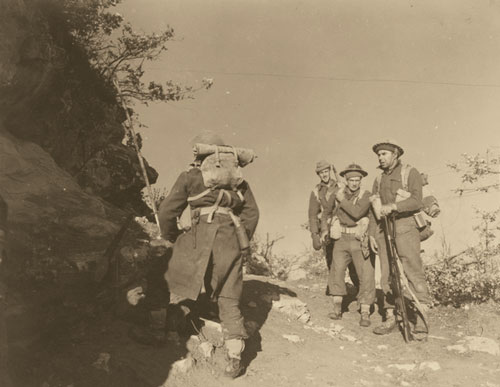 |
Towards midday the enemy started very heavy shelling and mortaring. During the afternoon the Germans tried to infiltrate between “B” and “D” Companies, WR/DLR, but their attempts to counterattack failed before accurate small arms and mortar fire. It was found that Point 826 was held in strength. Meanwhile the 1st Battalion, Scots Guards had attacked Mt. Alcino supported by the fire of “C” Squadron, PR. It was important to secure this feature in order to protect the right flank of the 12th South African Motorised Infantry Brigade. Mt. Alcino was a most formidable position, and owing to previous
casualties the 1st Battalion, Scots Guards were suffering from an acute
shortage of Officers and Platoon Sergeants.
|
|
After severe fighting
extending over three days the enemy withdrew from the mountain on the
evening of 21October 1944.
On 20 October 1944, the Germans launched several
counterattacks against the WR/DLR, but the battalion hung on to 806.
Accordingly it was decided to relieve the WR/DLR with the ILH/KimR, who
would then undertake the capture of Point 826. The ILH/KimR moved up
from 11th South African Armoured Brigades sector on 21 October 1944, and
took over on Point 806. The ILH/KimR came under the 12th South African
Motorised Infantry Brigade’s command, and the WR/DLR was put under the
11th South African Armoured Brigade’s command.
The flanks of the ILH/KimR were protected by the precipitous slopes of Mt. Salvaro, but this meant that the only line of approach for the attack on Point 826 lay along the narrow knife-elge ridge connecting that point with 806. North of Point 806, the ridge narrows and descends to Point 778, some 500 yards ahead. Then the ridge climbs again and four hundred yards further on is Point 826. The northern slope of Mt. Salvaro is also acute, but a low neck trends away to the north-east and finally connects the Salvaro feature with Mt. Sole. On 22 October 1944, visibility was extremely poor, and mist alternated with rain. Patrols were sent out to Point 778, and found the enemy occupying buildings in that area. That afternoon two platoons of the ILH/KimR made a brilliant raid on Point 778, and after a sharp fight took 45 prisoners. Counterattacks from Point 826 were beaten off. Prisoners taken on Point 778 came from no less than three battalions, and it appeared that Point 826 was held by a mixed group drawn from 94. Infanteriedivision.
|
|
Plans were made for the decisive attack on 23 October 1944. The FC/CTH were holding firm west of Mt. Pezza and patrolling vigorously in that area. The RNC were in rear of the ILH/KimR and when the latter battalion attacked, were instructed to take over Point 806. “B” Squadron, PAG was allotted harassing fire tasks. The attack was to receive unprecedented artillery support. As soon as the ILH/KimR had captured Point 826, the 1st Battalion, Scots Guards were to assault Mt. Termina. Lt. Col. R. Reeves-Moore decided to attack with “A” and “B” Companies, 1st Battalion, Scots Guards forward, and “C” following in close support. Considerable difficulty was experienced in getting food up to the attacking troops and “A” Company did not receive their evening meal until 01:30 on 23 October 1944, when it was cold and uneatble.
At 05:45 “A” and “B” Companies moved in to the attack, and the artillery let loose their tremendous bombardment. The assaulting troops advanced rapidly, so rapidly indeed that most of the enemy's defensive fire fell behind them. The enemy had returned to Point 778 during the night, and brisk fighting developed among the houses there. The German artillery and mortars now got the range, and heavy casualties were suffered by the attacking troops. Point 778 was finally secured at 07:15.
|
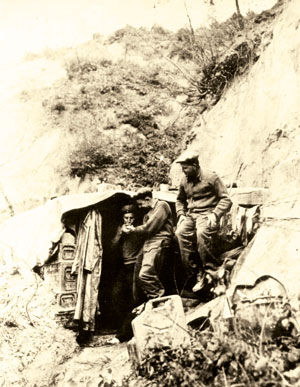 |
|
“A” and “B” Companies pressed on, but were met by
intense machine-gun fire from houses some 200 yards beyond the neck.
“C” Company moved up in close support, and “D” Company took over on
Point 806. A period of stalemate followed, during which the mortaring on
both sides was terrific. Finally “B” Company’s right hand platoon
succeeded in enfilading this position, while the centre platoon of “B”
Company made a front attack. The enemy withdrew at 11:30.
Under the cover of mist the leading troops worked their way forward up the southern slopes of 826. Suddenly the mist lifted, and they had to withdraw to cover under violent Spandau fire. Firepower was needed, and it was decided that after 40 minutes mortaring, the artillery would put down a five minute barrage, and then “A”, “B” and “C” Companies would charge the objective. Advantage was taken of the pause to bring up more ammunition and grenades a difficult task in the face of the enemy’s persistent and accurate shelling. As soon as the artillery ceased fire the attack went in. The enemy was outfought and outmanoeuvred and surrendered right and left. Positions were rapidly dug-in and consolidated in all-round defences and prepared for counterattacks. Other attempts to counterattack were smothered by artillery fire. Fortunately, the battalion had consolidated well-down the slopes of 826, and the enemy’s artillery concentrated on the summit itself.
Spasmodic shelling and mortaring continued throughout the night. The evacuation of casualties was a heart-breaking task, and many had to be left on the mountain in the cold and rain. The 1st Battalion, Scots Guards attacked Mt. Termine on the afternoon of 23 October 1944, but the attack was called off when an extensive minefield was discovered. The enemy abandoned the ridge that night, and it was subsequently found that none of the mines were armed. The capture of Point 826 marked the end of the most desperate close quarter fighting of the campaign - at least as far as South African troops were concerned. Mt. Salvaro was the highest and most dominating ground between Mt. Vigese and Bologna, and its occupation was essential to a further advance along the Reno or Setta valleys. Its conquest was a great tactical achievement, and although casualties had not been light, those of the enemy were far heavier. Indeed the 12th South African Motorised Infantry Brigade operations from Stanco to Salvaro were remarkable for the fact that ground which greatly favoured the defence was torn from a stubborn and skilful enemy, without his being able to exact a proportionate penalty in casulaties. The artillery fired 7369 rounds in support of the attack on Point 826 and RDLI mortars expended 1753 bombs. The 6th South African Armoured Division received no air support during these operations and success was due to the skilful handling of very powerful artillery, coupled with the self-sacrifice and sound tactics of the assaulting infantry.
|
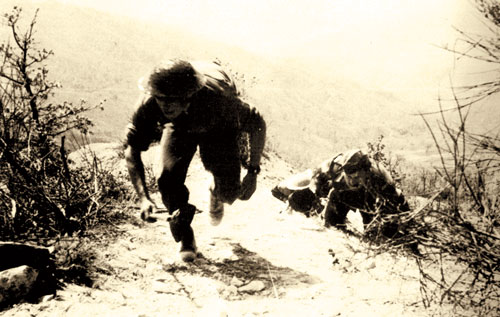 |
After this battle, the 6th South African Armoured Division was withdrawn for rest and maintenance. It was re-assigned from US IV Corps to direct command by the US Fifth Army to enable US Fifth Army Commander Lt. Gen. M.W. Clark to coordinate the 6th South African Armoured Division’s advance more closely with that of the US II Corps. The 6th South African Armoured Division’s major task became that of thrusting north towards Bologna covering the flank of the US 34th Infantry Division.
|
|
Combat Command “B” was to advance on Route 64,
the 24th Guards Brigade along the Setta Valley road, with 11th South
African Armoured Brigade and 12th South African Motorised Infantry
Brigade covering the high ground between the two. Opposing the advance
was the 16. SS-Panzergrenadierdivision.
By 25 October 1944, the 6th South African Armoured Division had waded the Setta Creek and taken Hill 501 below Mt. Sole, but the 24th Guards Brigade attack on Mount Sole was halted by torrential rains. The following day the continuing rains had turned to floods, isolating the 6th South African Armoured Division elements on Hill 501 and suspending all air support from the US XXII Tactical Air Command. Mt. Sole was not attacked again and the 6th South African Armoured Division was returned to the US IV Corps command on November 4th, 1944, and was given instructions for holding the front. The 24th Guards Brigade held the right flank, the 12th South African Motorised Infantry Brigade the centre, and 11th South African Armoured Brigade the left. Aggressive patrolling was ordered with a view to an eventual attack on Mt. Sole.
|
On 5 November 1944, the first frost occurred. Most of the men had now received battle dress but not a few individuals were still without it. Winter equipment, including rubber boots and leather jerkins, began to arrive. Each Battalion worked out a scheme for resting the troops. The plan generally favoured was to hold the line with three companies forward, and give one company a fire day rest. Leave started, and as Florence and Pistoia were virtually American cities, Prato became the 6th South African Armoured Divisional leave centre.
|
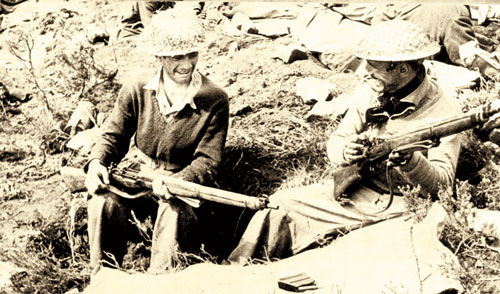 |
|
The Union Defence Force Institute established an
Out span club in Castiglione and arranged cinema shows and concert
parties. Supply problems were acute on the ice-coated roads and in the
perpetual rain. Hitherto the division had been assisted by the 10th Pack
Transport Company, whose muleteers were Italians. The Commander “Q”
Service Corps formed 6th South African Armoured Division Mule Pack
Detachment, whose muleteers were mostly Cape Corps men released by the
“Q” Service Corps Companies.
Reinforcements arrived and personnel from the 43rd Light Anti-Aircraft Regiment, SAAF were absorbed into Infantry Battalions. Throughout November the 6th South African Armoured Division patrols continued to operate well-forward. A number of clashes occurred, but 60% of the patrols had nothing to report. Ammunition supply was restricted, but the artillery took advantage of suitable targets. The guns also shot off a good many propaganda shells. The German artillery caused few casualties, but considerable annoyance and used a number of rocket projectiles, which had terrific blast effect. Even the Luftwaffe put in an occasional appearance during the full moon, and one raid on Castiglione caused 12 casualties. Detailed plans were worked out for the attack on Mt. Sole. The task was entrusted to the 24th Guards Brigade and on 1 December 1944, 5th Battalion, Grenadier Guards began a series of attacks designed to secure the outworks of the Sole - Caprara massif. The operations met with little success. The enemy’s positions were very strong, his mortar and machine-gun fire was heavy, and the ground was held by 16. SS-Panzergrenadierdivision.
|
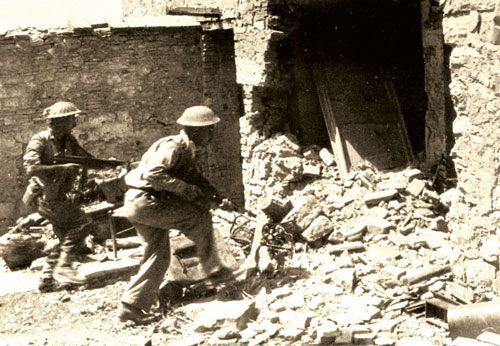 |
The 4/13th Frontier Force Rifles were put under the 24th Guards Brigade and relieved the 5th Battalion, Grenadier Guards. The 5th Battalion, Grenadier Guards opened its attack on 8 December 1944, and stubborn fighting continued throughout the week. The 4/13th Frontier Force Rifles gained some ground, and the divisional artillery gave support. But the German counterattacks were very determined, and his artillery fire extremely heavy. On 15 December 1944, the 4/13th Frontier Force Rifles withdrew to their original positions, and the fighting died down on the slopes of Mt. Sole. Snow fell on 21 December 1944, and on 28 December 1944, the capture of Mt. Sole was indefinitely postponed.
|
|
From now on administration became the chief
problem of the 6th South African Armoured Division. By 10 January 1945,
the snow on Point 826 was thigh deep, and the temperature had dropped to
20 degrees below freezing. Snowploughs and bulldozers were called on to
clear the roads, and pioneer companies and troops laboured to chip the
ice off road surfaces. The recovery sections were particularly busy, and
on 31 January 1945, Light Recovery Section recovered 547 vehicles, and
back-loaded 144. Tanks were incapable of moving unaided on the iced
roads, and 30th Heavy Recovery Section was called on to assist them.
|
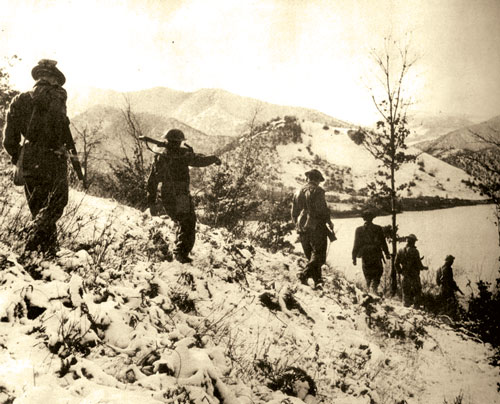 |
|
Winter clothing came forward in good quantities, including snow-shoes
and white snowsuits with hoods for use on patrol. Hot baths were
provided by the mobile bath units. As in the 12th South African
Motorised Infantry Brigade position at St. Ella, mules and porters had
to be used to get rations up to the forward positions. The food,
although mostly tinned, was good and was carried up to forward companies
in hotboxes. Skiing and tobogganing were popular recreations, but on 28
January 1945, rain fell and the temperature rose sharply. Then came the
thaw, adding greatly to the general inconvenience. Dugouts filled up
with water and mud and slush made many men wish that winter would
return.
The health of the troops remained good in these
conditions, although there were many cases of trench foot. Some blamed
the boots, other considered that foot-discipline was a fault. The front
remained static, but patrolling in the bitter cold of January was a grim
ordeal. Leaky boots and lack of waterproof trousers added to the
difficulties of moving across naked snow on clear nights. One WR/DLR
patrol took seven hours to cover a mile across snow and ice. The 6th
South African Armoured Division passed under command of the US II Corps
on 15 January 1945. This Corps instructed the 6th South African Armoured
Division to take a prisoner every three days. Battalions were required
to make raids 30 to 50 strong to secure identifications. On the night of
3 February 1945, the WR/DLR had a sharp clash with a German party near
Salvaro church, and secured a badly-wounded prisoner. By 10 February
1945, adequate identifications had been obtained of the enemy on the 6th
South African Armoured Division front. Deserters began to come in
daily, and there was no longer any necessity for raids.
|
Last Updated On Thursday, April 17, 2014 by Wayne at Battlefront
|
|